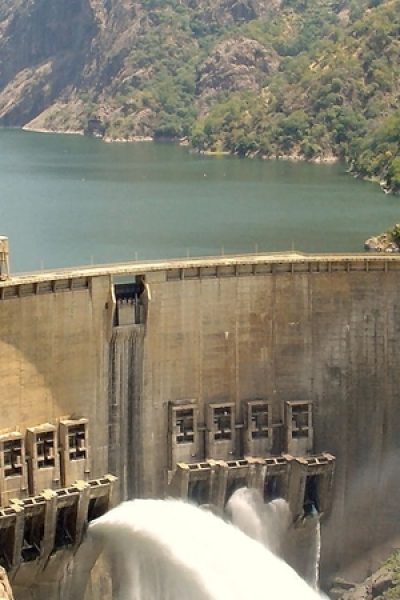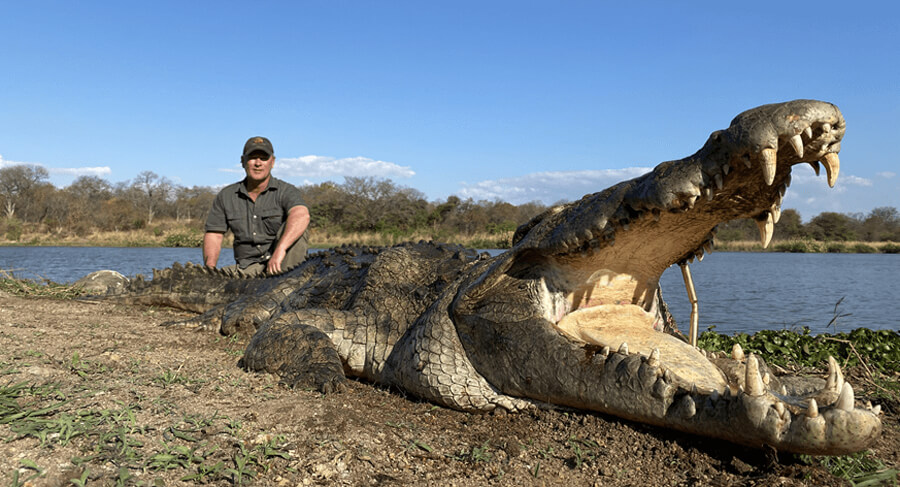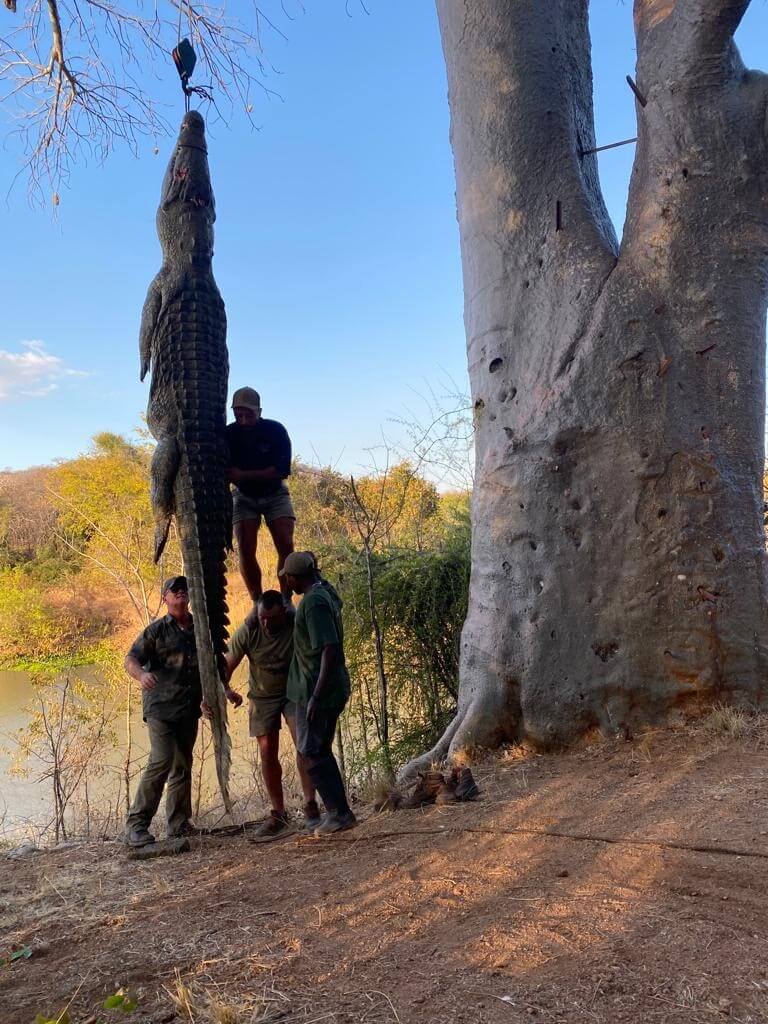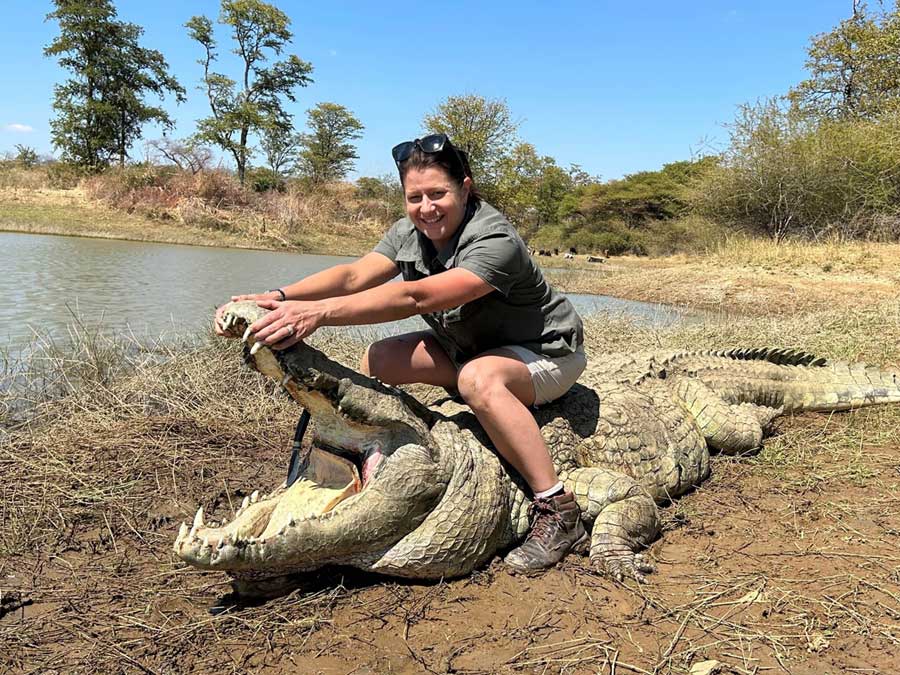[DYNAMIC-BLOGTABLEOFCONTENT]
I had the privilege of traveling to Mozambique earlier this year as an observer on a crocodile hunting adventure. I had been on a big game hunting safari in Mozambique before, but never for dangerous game, such as the man-eating Nile Crocodile.
Mozambique is a beautiful country, and I had never been to Cahora Bassa Dam. I had some knowledge of the hydro-electric system, and we drove past the plant from the airport on our way to the dam. The Cahora Bassa Hydro-electric Dam, is one of the largest hydroelectric projects in Africa, with construction starting in the late 1960s and continuing into the 1970s. Over the years, the dam has seen various upgrades and expansion efforts to increase its electricity generation capacity.
The dam has played a crucial role developing Mozambique’s energy infrastructure and has had a significant impact on the region’s power supply.

Nile Crocodile Hunting in Mozambique
The Hunting Adventure Begins!
Our big game hunting adventure began with a 4-hour drive from the airport until we reached the dam’s edge, where we stayed in a lovely guest house overlooking the water. We could see the legal (and illegal!) fishing boats trying their luck to catch the one that got away.
The following morning, we piled ourselves, our luggage, and our food supplies into two deep-sea fishing boats and crossed the great Cahora Bassa Dam. We needed the deep sea boats as the swells on the lake get rather large, and a normal boat would not handle the swells without capsizing. The Cahora Bassa Dam was huge! It’s approximately 303 meters (994 feet) long, and the dam creates a reservoir known as Lake Cahora Bassa, which has a surface area of about 2,700 square kilometers (1,042 square miles) when the reservoir is full. The reservoir is extensive, and stretches for a considerable distance along the Zambezi River.
Once we had successfully crossed the lake, we arrived at our campsite. The facilities exceeded our high expectations, especially since ice-cold drinks awaited us as we disembarked from the boat. This was a huge plus after a hot, yet exhilarating boat ride. Our excitement grew in earnest as we realized our big game hunting dream had become a reality! We decided to go out and scout an area nearby in preparation for the next day’s big game hunting expedition. Well, like most things in Africa, things did not go as planned…. And we ended up shooting a very nice crocodile that afternoon!
Yes, on the first day that we arrived, my husband shot his crocodile (he wastes no time!!)! So now the question was: “What would we do for the next seven days?” This is where it gets exciting as the observer, and we asked our outfitter if there were any possibility of another tag, for me (the observer), and because we had an awesome outfitter, another tag was arranged.
The preparation then began for the next hunt.

Time for another Big Game Hunting Adventure
First was a trip to the “shooting range,” a nearby cove where you can acclimatise to the terrain. I borrowed my husband’s .300, and even though I had not specifically trained for this hunt, my shooting was great, and I felt confident enough to start looking for my crocodile.
Taking the deep-sea boat, we went out to the southern side of the lake (our campsite was on the northern bank). It’s interesting that the Nile crocodile (Crocodylus niloticus) is a common species found in Lake Cahora Bassa and other water bodies in Mozambique.

Nile Crocodile Breeding Habits and Seasons
Here are some key points regarding the breeding habits and seasons of Nile Crocodiles in Mozambique:
- Breeding Season: Nile crocodiles typically have a breeding season that coincides with the start of the rainy season in Mozambique, between November and March. During this period, water levels in rivers and lakes rise, creating ideal conditions for nesting and hatching.
- Nesting Sites: Nile crocodiles construct nests on riverbanks, sandy shores, and other suitable locations near water. They create mound nests using vegetation and mud. The females carefully excavate the nests to lay their eggs.
- Egg Laying: Female Nile crocodiles lay a clutch of eggs in their nests, ranging from 20 to 80 or more eggs, depending on the size and age of the female. After laying the eggs, they cover them with additional vegetation and soil to protect them from potential threats and temperature fluctuations.
- Incubation: The eggs are incubated by the heat of the environment, as the crocodiles do not actively provide parental care. The incubation period lasts approximately 80 to 90 days, depending on the temperature. Higher temperatures can result in shorter incubation periods.
- Hatching: The hatching of Nile crocodile eggs generally occurs during the wet season when the rivers and lakes are full. The hatchlings have a small, temporary egg tooth, which they use to break out of the eggshells. They are vulnerable at this stage and are at risk of predation.
- Protection of Hatchlings: Female Nile crocodiles may stay near their nests and protect the hatchlings during the early stages of their life. The young crocodiles live near the water, where they have a higher chance of survival.
It’s essential to note that the specific timing of the breeding season and nesting habits can vary based on local environmental conditions, water levels, and other factors. Additionally, one of the reasons they make the list as one of the Dangerous 7, Nile crocodiles are known for their aggression and are considered dangerous apex predators, so caution is required when observing them in the wild. Crocodile breeding and behavior are complex, and it’s crucial to respect these animals’ natural habitats and behaviors. We tracked down a monster crocodile just off an estuary. The crocodile we found was seemingly unafraid of humans, and I did wonder how many humans he had killed over his lifetime.
We estimated this crocodile (judging by his length) to be just under 100 years old, so it had survived two civil wars, and we estimated that he had tasted his fair share of human meat over that time!
Sitting on the embankment, setting up the rifle and the sticks, I could feel my heart pounding and had to remind myself to be calm and take my time (wise words from my husband, I could hear myself repeating). I went through the plan again, first a spinal shot, then a lung shot and then another aim at the spine. This is almost standard procedure, and three shots is the norm.
The reason for this is, that if you sever the spine on the first shot, there is less chance of him jerking and making his way back into the water (to be lost forever together with any thoughts of a trophy or handbag!). The lung shot, in case the spine shot is slightly off target, and then the last shot just to confirm that it is in fact dead. When it comes to calibers, anything from a .243 would work, but I am partial to a .300 win mag, I used that on my African crocodile hunting adventure. However, a 243, 270, 308, 30-06, 300 WSM, 300 Win Mag, and 375 are also great for crocodile hunting in Mozambique. Bullet selection is always personal, but expansion soft point bullets are preferable.
I did hear around the campfire how a crocodile was brought in, a seemingly perfect spinal shot, and was on the skinning room floor when he suddenly came too again, and scared a few decades off the skinner’s life. It turns out that the shot was slightly misplaced, and instead of severing the spine, gave the crocodile a concussion, and he was out for a while! A very scary story indeed!
My first shot severed the spine, the second hit the lungs, but I’m embarrassed to admit it, but by then the adrenaline had got the better of me as I saw that the first shot was on the money, so the placement of the third shot was anyone’s guess…
What a monster!!!! We measured him at 15,1 feet! Getting up close after the hunt is always a little nerve-racking, as with any dangerous game, you need to make triple sure that your animal is dead and not concussed before approaching. The crocodile I had hunted was definitely dead, and we could now get up close and see how big he was and that he had all of his tail. An old crocodile like this usually has a piece of his tail missing as they fight each other viciously during mating season, and they also have the odd run-in with hippos, that can also cause major damage. My crocodile had all the scars to prove that he had taken part in his fair share of fighting, but to his credit, he had managed over all these years keep his tail intact.

Scars on Big Game Hunting Trophies
Crocodiles are known for their territorial and aggressive behavior, and they often engage in battles with other crocodiles, particularly males in the breeding season. These battles can be intense, resulting in scars on their bodies.
The scars are usually a result of the following:
- Fighting for Territory: Crocodiles are territorial, and establish and defend their territories, especially during the breeding season. Male crocodiles may fight with each other to establish dominance over a particular area. These battles can involve biting, shoving, and thrashing in the water.
- Mating Battles: During the breeding season, male crocodiles may engage in battles to compete for the attention of females. The victor of such battles gets the opportunity to mate with the female. These mating battles can result in visible scars on their bodies.
- Feeding Competition: Crocodiles are opportunistic predators and sometimes compete for food. When multiple crocodiles attempt to feed on a single prey item, they may engage in aggressive behavior, including biting and snapping at each other, leading to scars.
Scars on crocodiles can vary in size and appearance, depending on the severity of the battles and the healing process. The crocodile’s tough, scaly skin can withstand such fights and provide some level of protection, but even then, they can still sustain injuries.
These scars are often part of the natural life of crocodiles and are used to signal dominance and experience to other crocodiles. I think my crocodile had lots of experience!!
We had to skin him on the shoreline as we were on the Southern bank of Lake Cahora Bassa, and our camp was on the Northern shoreline. It was fascinating to see how the crocodile, like many other reptiles, can exhibit post-mortem movement or muscle twitching after death. This phenomenon is known as “cadaveric spasm” or “post-mortem activity.” This is not unique to crocodiles, but observed in various animals, including reptiles and mammals.
Reasons for post-mortem activity
There are several reasons for this phenomenon:
- Nerve Impulses: Even after an animal has died, electrical activity can persist in its nerves and muscles. Nerve cells, or neurons, can continue to generate electrical impulses for some time after death. This can lead to muscle contractions or twitching.
- Chemical Changes: Chemical changes that occur during the dying process, such as the release of neurotransmitters, and oxygen and energy source depletion, can lead to muscle contractions or spasms.
- Lack of Complete Muscle Relaxation: At the moment of death, muscles may not completely relax. If muscles remain contracted, they can cause twitching or movement after death.
- Delayed Cellular Shutdown: The cells in the body do not all shut down simultaneously, and some cellular processes may continue fleetingly after death.
It’s important to note that these post-mortem movements are not a sign of life or consciousness; they are purely the result of physiological processes that occur as the body transitions from life to death. The duration and extent of post-mortem movement can vary from one situation to another and influenced by factors such as the cause of death and environmental conditions.
Big Game Hunting in Mozambique
If an adrenaline-filled trip big game hunting in Mozambique sounds like something you want to pursue, click here for further information and packages.
Read more about hunting in Mozambique here.
Author: Tamlyn van Wyk
